Proposed change could reshape Endangered Species Act. Here's how it affects Washington state
Published in Science & Technology News
A big change could be coming to U.S. wildlife conservation policy.
In mid-April, the National Oceanic and Atmospheric Administration and U.S. Fish and Wildlife Service announced a proposal to change how the term “harm” would be defined in the Endangered Species Act.
Under the ESA, it’s illegal for someone to “take” a protected endangered species, a term the law defines as “to harass, harm, pursue, hunt, shoot, wound, kill, trap, capture, or collect, or to attempt to engage in any such conduct.”
Change to Endangered Species Act
According to Paula Swedeen, policy director at Conservation Northwest, use of the word “harm” in that definition is currently understood to include the destruction of endangered species’ habitats. However, the proposal would change that.
“The proposal is to narrow the definition of ‘harm’ to things that directly physically injure animals or kill animals,” Swedeen said. “For a very long time the definition of harm includes adverse habitat modification, the logic being if a species doesn’t have a place to live, that’s tantamount to killing them.”
The proposal is currently in the public comment period, which closes on May 19. Members of the public can submit a comment online at the Federal Register’s website.
According to Swedeen, the goal of the change is to bring the definition of “harm” in the ESA closer to what the Trump administration believes is its originally intended meaning.
“The federal government’s argument, the Trump administration’s argument, is that the definition of harm has been too broad, and it was never intended to include habitat modification,” Swedeen said.
However, in Swedeen’s opinion, the changes would leave the ESA almost completely unenforceable.
“The problem with that is that you can’t really meaningfully implement the Endangered Species Act with that narrow a reading of the law,” Swedeen said.
Endangered Species Act changes impact on Washington
So how would ESA changes impact Washington?
Washington state has its own conservation plans that are already in place on state lands. According to Swedeen, there’s reason to think that the changes to the ESA won’t impact those too much.
“One of the ambiguities is the Federal Register Notice says that the changes are future looking, and so any permit that’s issued – for instance, Washington state has several, what are called habitat conservation plans … The reading of that Federal Register Notice is that it wouldn’t affect those permits. But I can’t imagine that there wouldn’t be some blowback or consequences to preexisting permits,” Swedeen said.
According to a 2020 congressional report, there are over 12 million acres of federal land in Washington. That means that 28.6% of the state’s total area is federally owned.
Future conservation plans would be subject to the new definition, which is particularly notable since the U.S. Forest Service is in the process of revising its Northwest Forest Plan. That doesn’t necessarily mean the plan would take on any changes potentially made to the ESA, but it would lower the bar that the forest plan needs to meet in order to comply with the ESA.
“The Forest Service is undergoing a revision of the Northwest Forest Plan, and that’s not done yet,” Swedeen said. “A good chunk of the management approaches under the Northwest Forest Plan are based around conserving endangered species and their forested habitats. I think that in having to re-up or renew this plan, you renew the consultation with the Fish and Wildlife Service on whether or not the plan complies with the Endangered Species Act. So now there would be a much lower bar on whether or not the plan meets the Endangered Species Act.”
Which species in Washington would be affected?
According to Swedeen, the spotted owl is one of the best examples of how endangered species could be put at risk by the proposed new ESA reading.
“They require old growth, or near-old growth conditions in forests,” Swedeen said. “You cut their forest down, you will eventually kill them, because they’ll fly around and try to find a place to live. They might settle in a plantation, but they won’t find enough to eat, or it won’t protect them from temperature changes, or won’t protect them from predation.”
Swedeen said that the proposed changes could also have a particularly big impact on other endangered species in Washington, like the grizzly bear, which the state has worked hard to restore.
“It could be harder to get the Forest Service to undertake actions that are consistent with recovery,” Swedeen said. “I think about bull trout, I think about Chinook (salmon), I think about orca. I mean, there’s a whole host of species.”
_____
© 2025 The News Tribune (Tacoma, Wash.). Visit www.TheNewsTribune.com. Distributed by Tribune Content Agency, LLC.







Comments